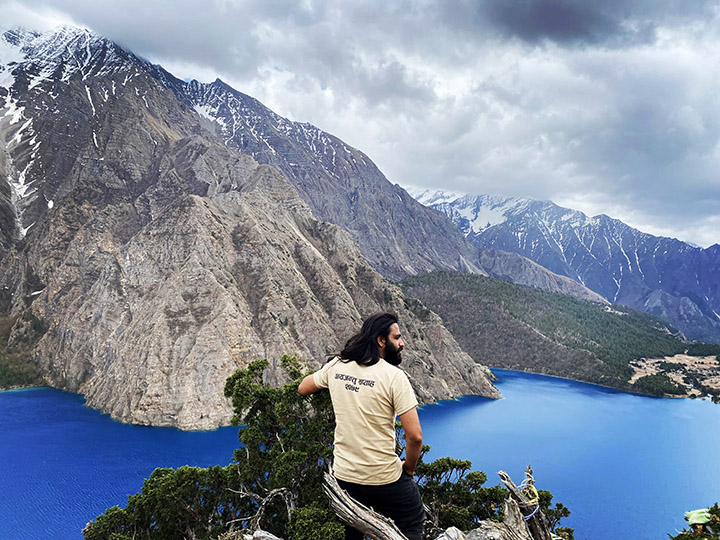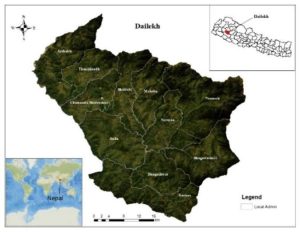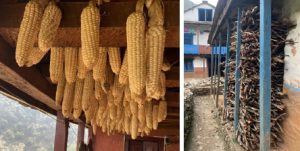
Reframing Adaptation: A Multilevel Analysis of Collective Action, Power, and Politics of Climate Change Adaptation in Climate Vulnerable Communities
Churchill Exploration Fund Trip Report
Expedition Location: Dailekh district in Western Nepal
Expedition Dates: October 15, 2021 – August 10, 2022
Funding Support: Dan & Betty Churchill Exploration Fund
Research Background
Global climate change presents extreme challenges to both social and ecological systems (Pachauri et al., 2015). Current understandings of climate change adaptation problems seek the cooperation of multiple actors at various scales to meet the objectives of sustainability, equality, and inclusiveness that address social, environmental, economic, and political requirements for present and future generations (Adger, 2003; Adger et al., 2005; Ostrom, 2010; Agrawal et al., 2012; Eriksen et al., 2015; McElwee, 2016; O’Reilly et al., 2020). Most studies on adaptation to date are highly focused on biophysical changes such that ignoring the social, political, or economic determinants of adaptation (Marino and Ribot, 2012; Eriksen et al., 2015; Nagoda, 2015). In this research, I argue that adaptation is equally governed by social, political, and economic factors across scales. This research uses a multilevel governance framework and engages the theory of collective action with attention to issues of power to investigate the political nature of climate change adaptation. This study explores how power and politics can limit or foster collective action and affect adaptation planning and decision-making across scales. This research uses Nepal as an ethnographic case study to answer the following research questions:
Research Questions
- How power is determined across scales and how does this affect collective effort in adaptation planning and decision-making across scales?
- How does collective action occur across scales and what is its role in achieving successful, inclusive, and equitable community-based climate adaptation?
- How do farmers use collective identity to challenge the influence of power and politics in climate change adaptation policies?
Study Area:
This research is situated in Nepal, a developing country that is recognized as a highly vulnerable nation yet has seen few detailed scientific studies on climate change. This research builds on preliminary fieldwork completed in the summer of 2019 that included interviews with farmers and organizations working on the adaptation. I will conduct fieldwork in the Dailekh district in Western Nepal (Fig 1.). I chose this site because it is located in the country’s most climate-vulnerable region (MoFE, 2021). Climate adaptation programs like National Adaptation Program of Action (NAPA) and Local Adaptation Plans of Action (LAPA) along with multiple forms of institutions, NGOs, and public and private groups are working in the study area. These characteristics make this an excellent location for this case study because multiple institutions, groups, projects, and other stakeholders working in the study area will provide a good platform to study both the role of power and collective efforts within the community and among institutions across scales. In addition, I worked as a district climate change specialist for more than one year in Western Nepal and have an abundance of experiential knowledge to inform this project.

Methods and Results Achieved
This study initially started in 2019 as an exploratory preliminary fieldwork. During that phase, I was able to determine the study area and probable research participants. After doing some informal talks during the preliminary phase, I generated some robust research questions. In 2021, I started detailed ethnographic fieldwork across scales (local, provincial, and federal) in Nepal for 10 months. This ethnographic research involved participants’ observation, household interviews, key informant interviews, focus group discussions, oral histories, and policy reviews. The Institutional Review Board (IRB) took a bit longer time for final approval and I utilized that time for building relationships and collaboration with local communities, institutions, and governments. The prior relationship and further collaborative rapport-building supported to smooth completion of the fieldwork on time.
After the IRB was approved, I started some local-level interviews with three irrigation canal communities that I selected earlier. However, throughout my fieldwork, I had to travel to Surkhet (provincial government) and Kathmandu (federal government) frequently. In March and April, I did key informant interviews with key informants from different governmental organizations including ministries, Non-Governmental organizations (NGOs), International Non-Governmental Organizations (INGOs), and civil societies. My intention was to understand who and how the adaptation plans and policies are planned and decided at the federal level. I also tried to understand the relationship between provincial and local governments with the federal government and how that matter in adaptation planning, decision-making, and implementation. I had to remain in Kathmandu in May to finalize the interviews with 3 donors who funded adaptation projects in Nepal including International Fund for Agricultural Development (IFAD). Due to some circumstances, I had to do partial provincial-level interviews in Kathmandu. In June’s first week, I completed a provincial interview at Surkhet and headed to Dailekh for the remaining community-level interviews. It was a lucky moment because I got a chance to observe the local election of Nepal in Dailekh because it gave me more sense of the political understanding of climate change and the knowledge of climate change among political parties. In June and July, I finalized the remaining local-level community-based interviews.
Currently, I am translating and transcribing interviews collected in Nepal. Starting on February 20, 2023, I will start coding interviews using NVIVO and start preparing an outline of my dissertation. Although, I have not analyzed my data, based on my transcribed data I can claim that the federal government has formulated and implemented some important national climate change policies and programs in Nepal. However, the provincial and local governments have not formulated any climate change adaptation-based policies and programs. Nepal has entered the federal system for 6 years, however, most of the resources, knowledge, and authorities are centered at the federal level rather than provincial and local governments. The provincial and local governments do not have direct access to international resources due to which most of the programs gather at the federal level and are implemented through the federal government. The planning, decision-making, and implementation of climate change policies and programs still follow an entirely top-bottom approach although the objective of certain programs such as Local Adaptation Plans of Action was to promote a bottom-up approach in climate adaptation programs. The socio-political understanding of climate adaptation is poorly understood at all levels in Nepal as most of them discussed focusing on bio-physical dimensions of climate change. Following are some important quotes that I generated from fieldwork:
“Yes, I want to add one more thing. While the ASHA project prepared LAPA they categorized houses from V1 to V4, where V4 represents the most climate-vulnerable households and V1 represents the least vulnerable houses. The activities are targeted at V4 houses where the majority should be Dalits (low-caste people) and poor households. But you know what happened here? While categorizing the households into V1, V2, V3, and V4, the Dalits and poor households were not invited. The organization was under the influence of elite people from our community and they put their names in V4 categories and the Dalits people into V1 categories. This way the benefits and major projects went to rich households who were not vulnerable. For example, the elite people listed in V4 got multiple benefits but the actual vulnerable people who were listed in V1 and V2 hardly got some benefits. This is a political game over vulnerable people by organizations and elite people. They still use the tag V1 and V4 to distribute resources or benefits from new organizations that are coming into the village. This will make vulnerable people more vulnerable and the elite people stronger”.

“In our context, the understanding of adaptation is popular in the climate change sector only. However, I would say that climate change is only an aspect where adaptation works. There are several other areas such as social, political, and economic aspects where adaptation should work equally. Climate change is a new problem for us. However, the social and political problems that existed for generations are still prevailing, which increases the vulnerability of marginalized communities. We should think about these aspects of adaptation as well to secure reduced social, political, and economic vulnerability”.

”I would say that happens to more extent. To give the reason, I will provide an example. In the GCF’s Building a Resilient Churia Region in Nepal (BRCRN) project, there are 26 river systems as target areas. In these 26 river systems, they have plans to work only on the upper side of the river. It says that it is working in a river system but the focus is only on the upstream and the downstream of the river is ignored. But you know more than 90% of the population in that region is residing on the downside of the river. They are raising their voices and demanding to implement programs such as river bank management, private plantation, public and river bank plantations, etc. on the downside of the river as well. But that project is only focusing on the upper side of the river. It is mostly a donor-driven idea but not a people-centric idea”.
“I feel that while making plans, policies, and acts at the federal level, we are still unable to secure the meaningful participation of local and provincial governments. If the participation was secured they would have multiple queries and concerns regarding plans and policies”.

Acknowledgments
This PhD dissertation research work was made possible by an award from a couple of Dan & Betty Churchill Exploration Funds, the Chase Distinguished Research Assistantship, the Lambda Alpha Grant Award, and the Graduate Student Governance degree-related awards. My advisor Dr. Cindy Isenhour and other committee members are helping me in every step of this ongoing research. I am grateful to Social Service Center (SOSEC) Nepal for supporting my research as a local collaborator. Betty Lee and Rebecca Addessi from the Climate Change Institute played all the research participants from Nepal who are currently providing their valuable time and crucial information to this project. I also take a moment to thank all the research participants from different areas of Nepal.
References
Adger, W. N. (2003). Social capital, collective action, and adaptation to climate change. Economic Geography, 387-404.
Adger, W. N., Arnell, N. W., & Tompkins, E. L. (2005). Successful adaptation to climate change across scales. Global environmental change, 15(2), 77-86.
Agarwal, A., Perrin, N., Chhatre, A., Benson, C. S., & Kononen, M. (2012). Climate policy processes, local institutions, and adaptation actions: mechanisms of translation and influence. Wiley Interdisciplinary Reviews: Climate Change, 3(6), 565-579.
Eriksen, S. H., Nightingale, A. J., & Eakin, H. (2015). Reframing adaptation: The political nature of climate change adaptation. Global Environmental Change, 35, 523-533.
Marino, E., & Ribot, J. (2012). Adding insult to injury: climate change, social stratification, and the inequities of intervention. Global Environmental Change, 22(2), 323-328.
McElwee, P. D. (2016). Forests are gold: Trees, people, and environmental rule in Vietnam. University of Washington Press.
MoFE. (2021). Vulnerability and Risk Assessment and Identifying Adaptation Options: Summary of Policy Makers. Ministry of Forests and Environment, Government of Nepal. Kathmandu, Nepal.
Nagoda, S. (2015). New discourses but same old development approaches? Climate change adaptation policies, chronic food insecurity and development interventions in northwestern Nepal. Global Environmental Change, 35, 570-579.
O’Reilly, J., Isenhour, C., McElwee, P., & Orlove, B. (2020). Climate Change: Expanding Anthropological Possibilities. Annual Review of Anthropology, 49.
Ostrom, E. (2010). Polycentric systems for coping with collective action and global environmental change. Global environmental change, 20(4), 550-557.
Pachauri, R. K., Mayer, L., & Intergovernmental Panel on Climate Change (Eds.). (2015). Climate change 2014: Synthesis report. Intergovernmental Panel on Climate Change.

